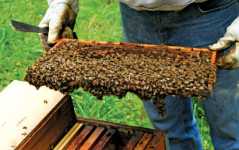CSI In The Beehive

Dennis vanEngelsdorp, the Pennsylvania Department of Agriculture’s acting state apiarist, began a recent presentation with this startling statistic: 36% of U.S. honey bee colonies died last winter. “That’s an astronomical amount of bees,” said vanEngelsdorp, who is coordinating wide-ranging efforts by researchers across the country. “Seeing all those dead bees is just downright depressing.”
Speaking at the Almond Board of California’s annual Honey Bee Seminar in Modesto, CA, in October, vanEngelsdorp titled his talk: “Honey Bee Declines — CSI In The Beehive.” Almonds are the first crop in the country to bloom, in February, and about three-quarters of the nation’s transportable bees are brought to the Golden State each winter prior to bloom. But vanEngelsdorp emphasized that growers of all types should be concerned. “Modern agriculture relies on a movable honey bee force,” he said.
Colony Collapse Disorder (CCD) has gotten a lot of media attention, and rightly so, but vanEngelsdorp touched on a number of issues regarding honey bees in his engaging presentation.
– Honey bee losses are not new. The Greek philosopher Aristotle was the first to report of a wide-scale failure, and there have been many others through the centuries that sound very much like CCD, including Ireland in 950, Colorado in 1891, Texas and Louisiana in 1960, and Australia in 1976. “Is CCD something new? No one really knows,” he said. “But in scale, it’s certainly something new.”
– The 36% loss figure is attributed to four main factors. The figure was based on an exhaustive survey of beekeepers, in which they were asked what killed their bees. They cited CCD, poor queens, starvation, and varroa mites. The mites feed on the bees and then spit protein into them that breaks down the bees’ immune system, said vanEngelsdorp, predisposing them to a host of other problems.
– The migratory nature of beekeeping is not to blame for CCD. While many have made this claim, researchers have found no evidence that it’s true. They’ve also found no evidence of some other supposed causes, he said, including cell phone towers and alien abduction.
– CCD is caused by something either contagious or that involves common exposure. An exhaustive study in which samples were taken from both CCD and non-CCD bee yards in Florida and California clearly showed that weak colonies were found much more often next to other weak colonies.
– A prime suspect last year, Israeli Acute Paralysis Virus, was found in only 47% of CCD colonies. In fact, CCD might not be due to something that bees have at all, said vanEngelsdorp. It could be due to something vital that they lack, such as bacteria in the gut that aids digestion.
– Growers sourcing Australian package bees should be aware of potential problems involving varroa mites. The bees come with zero varroa mites, but at the end of the season, they had much worse mite problems than did the American bees. That indicates, said vanEngelsdorp, that American bees have developed a certain amount of resistance. “If you’re using Australian package bees,” he advised, “you might want to get U.S. queens in there.”
Interest in the problem is intense and widespread, which is encouraging. The media attention has been incredible, said vanEngelsdorp, who’s given numerous interviews. He certainly doesn’t mind, as that can only help to get more funding for research. It’s also encouraging on a more basic level, showing the public in general really cares.
“Everyone gets — at a gut level — that a world without bees is bad.”









